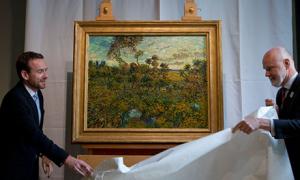Van Gogh

September 11th, 2013 - Lahore, Pu
Van Gogh's Sunset at Montmajour – even great artists have bad days
How could Van Gogh have painted this clogged and clumsy 'new' work – and in the same summer his genius reached the heady heights of Sunflowers?
Not all works of art that happen to have been painted by great artists are sizzling masterpieces. Even Van Gogh had his off days, as we've learned from the Van Gogh Museum's discovery of a "new" painting by their man this week. Sunset at Montmajour (1888) was until recently dismissed as a fake or misattribution, its authenticity rejected by the same museum that has now announced it as an exciting discovery.
What has changed? Scientific knowledge, it turns out: this painting uses the very paints Van Gogh had on his palette in 1881, and the museum is now able to identify them in precise detail because it is engaged in a comprehensive study of the inner structure of Van Gogh's art.
But it is all too easy to see why previous examiners were reluctant to call this a Van Gogh. The painting is just not that wonderful. If it vanished again tomorrow the world would not be much poorer, for this uncharismatic daub is a mere footnote to Vincent's brilliance.
His intense, explosive touch is there – just. But the clogged colours and clumsy composition show his originality struggling to overcome influence, tradition and nerves. He is visibly overburdened here by the heritage of the great Millet and the awful Adolphe Monticelli.
Van Gogh's Sunset actually looks as if it could be a homage to Monticelli's Sunrise (1882-4); his vinegar colours haunt the muted spectrum of this "new" painting. Monticelli is forgotten today, but this 19th-century painter from the south of France was a hero to Van Gogh, maybe even one of the reasons he moved to Arles in 1888, a couple of years after Monticelli's death.
For centuries, downcast, tobacco-stained colours were thought to be the mark of taste and truth in landscape art. It's fundamental to Van Gogh's genius that he breaks with all that muggy mud to paint living light. But in this work, his vision is hobbled. We are told it was painted in Arles in his golden summer of 1888, when he hit new heights of genius. But are they really, really sure it's not a fake? The science is unquestionable, I suppose.
Academics love to complicate the picture, and finding a painting that's so botched, dating from the very summer when he painted Sunflowers, will delight those who revel in art history's finer ironies.
For the rest of us, this painting is one to shrug off – a tired afternoon in a life of incandescent creativity.

